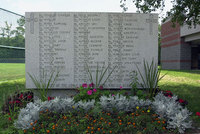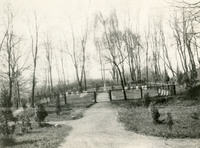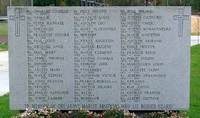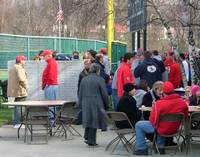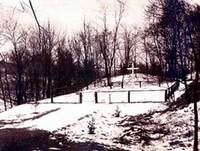Marist Brothers Cemetery at Poughkeepsie
By Dr. Brian Henry Desilets, Dr. Linus Richard Foy, & John Patrick Noone
In 1909 Brother Charles Camille, assistant master of novices, died from meningitis after an illness of only three days. Thus the brothers decided to establish their own cemetery in a small hollow at the south end of the property and Brother Charles was the first to be buried there. In 1913 Brother Angelicus, assistant general, urged the Provincial Council to make this the definitive grave site and to beautify it.
It was modeled on traditional cemeteries in rural France. In 1921 it was surrounded by a white stone wall built by Brother Paul Acyndinus. Each grave, which was dug by the novices, was marked with a cross monument displaying biographical information such as date of birth, death and number of years with vows. As the cemetery expanded, the rock encountered made the regular use of a jack hammer necessary. The last grave was filled in 1953, and a larger cemetery was developed on the Marist Brothers' property in Esopus, New York.
The photo on the lower left shows how the cemetery looked for a period of 80 years. It was not large, containing only 48 graves. The graves were laid very close to one another with a head stone marking each grave.
In 1960, the college purchased eight acres south of the cemetery from the New York Central Railroad. For about a decade the college filled in the field between the cemetery and the railroad spur which made the hollow more pronounced. By 1972 the area south of the cemetery became the obvious choice for a modern field house.
The first choice was to move the remains from the Poughkeepsie cemetery to the one in Esopus. The college attorneys warned that New York State had strict laws concerning the relocation of graves. Permission of the heirs had to be obtained, and since the deceased were never married, the 'heirs' were their siblings and their descendants. Since most of them had lived in France, this made relocation of the cemetery virtually impossible.
Brother Nilus Vincent Donnelly suggested that the cemetery remain in place, but the ground be filled to the height of the surrounding areas. He personally laid the individual grave markers over each grave, then bulldozed the walls inward and began the processing of adding 20 feet of fill. He noted the exact boundaries of the cemetery and the college agreed never to build on the site.
The college purchased a large single monument listing the names of those buried in the cemetery and placed it over the cemetery grounds. The names are also included in a special plaque at the base of the Calvary scene in the Esopus cemetery.
Cemetery at Marist College
By Marists All
Besides the Brothers listed in this monument, there were memorial plaques for Postulants who had died: John Graham, who died in 1924 and J. Hanley who died in 1911, and Juniors, Gerard Bouffard who died in 1927 and Leo Arsenault who died in 1937. These were buried with their natural families.
The cemetery at Saint Ann's Hermitage was started when Brother Charles Camille died in 1909, the year after the Brothers purchased the Bech property. It was located at the southern border of the property, just north of the property owned by the New York Central Railroad and not used by the railroad, so formed a natural bucolic backdrop for the cemetery.
The original wire fencing was replaced with a white wall, and each grave was marked with an iron cross and a small plaque indicating years of birth and death and years as a Brother. The cemetery was located in rocky ground, which made expansion impractical. Under the supervision of Brother Mary Andrew, Provincial Treasurer, a new cemetery was planned on the Brothers' Esopus property. By adding clean fill, a space was developed for up to 300 burials.
After the purchase of the seven acre NY Central parcel, the college accepted clean fill to raise the level of the ground, so that eventually the cemetery was almost 20 feet below the level of its surroundings. About 1973, when the McCann center was planned for construction south of the cemetery, the initial plan was to relocate the Poughkeepsie graves to the Esopus cemetery. However, legal counsel warned that effecting this might take up to two decades of legal activity; this advice was based on counsel's experience with a similar Old Dutch cemetery near Saint Francis Hospital. The decision was made to leave the graves intact, raise the level of the cemetery to the new level, erect a new monument and have the college warrant that no construction would be done above the original cemetery.
The college officials took great care not to allow the expansion of the McCann Recreation Center to impinge on the location of the cemetery. When the cemetery was covered, Brother Nilus Donnelly marked the location on a topological map, but in the 35 years since, the map has been mislaid or destroyed.
Brother Don Kelly, who still teaches mathematics at Marist College, took it upon himself to pinpoint the exact location of the cemetery. In his own words:
The monument itself has been moved several times, but remains close to the actual burial grounds.
Marist Brothers Cemetery 1909-1953: Wall along Delafield Street
The Marist Brothers cemetery was placed at the lowest end of the Bech property, just north of the Myers parcel. It was established in 1909 when Brother Charles Camille died at the age of 23. Creating a cemetery on the Brothers property was commonplace in Europe and even common in the United States, where many family cemeteries were located on family property. Later the practice changed to creating cemeteries adjacent to the church. When these filled, the practice evolved to central cemeteries. Poughkeepsie Rural Cemetery holds the remains of many who were originally buried next to their churches.
"Once there was a distinguished looking, six foot high concrete wall along Route 9 from the South entrance to the North entrance. Brother Paul Acyndinus built this over several years with hand-cast concrete blocks. I know because as a Novice I was assigned to work for an hour a day making them in iron molds, four each day. It is ironic that it was I who demolished this wall in 1966. It had begun to disintegrate, and some people said that it made the campus look like a prison. The wall around the old cemetery was built the same way and embellished with colored glass mosaics. Novices were sometimes assigned to go the the city dump and pick up discarded colored bottles which they brought back and broke into usable sized pieces for the mosaics." page 7 of Brother Nilus Vincent Donnelly's memoir Memories of 75 Years.
The cemetery had two rows of graves on each side of the center aisle. A monument was placed r over each brother's grave. Later, a small concrete rectangular frame was placed over each grave, and flowers planted within each frame. Neat as it looked from above, the coffins were not always aligned. There was considerable rock and some graves had to be completed with a compressor and jackhammer. Others were placed slightly out of line to make use of available dirt and bypass rock. The graves were dug by the novices, with the novitiate building the closest building to the cemetery. I know this because I was one of those assigned to dig several graves!
"One of the greatest honors of my Novitiate days was being assigned to toll once a minute, the large bronze bell on the Novitiate veranda as the cortege passed on the way to the cemetery to bury one of the Brothers who had died. This bell is now in the tower in front of the chapel." page 8 of Brother Nilus Vincent Donnelly's memoir Memories of 75 Years.
By 1953 the cemetery was full, and expansion would have been difficult because of the rock formations. The Brothers established a second cemetery in Esopus New York which has been in use since 1953.
An attempt was made to relocate the graves in Poughkeepsie to Esopus, but the legal technicalities became formidable. Since the level of the original cemetery was about 15 feet below the level established for the Myers parcel site of the proposed McCann Athletic Center, just south of the cemetery, Brother Nilus carefully turned over the crosses at each grave, and broke the wall leaving the stones in place to mark the border of the site. The College agreed not to construct any edifices over the cemetery, and established a monument to be placed over or near the cemetery site.
Source: Marist Land History: Marist Brothers Cemetery 1909-1953
Marist College | Marist Archives & Special Collections | Contact Us | Acknowledgements
